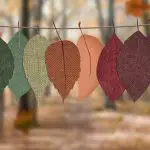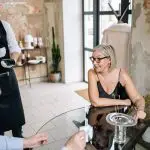Are you on the hunt for vintage velvet fabric? Look no further!
This essential how-to guide will show you where to search, how to identify genuine pieces, and offer tips on choosing the perfect color and pattern.
Discover the different types of velvet and learn how to care for your vintage finds.
Get ready to incorporate beautiful vintage velvet into your designs and create a unique and timeless look.
Let’s dive in!
Table of Contents
Where to Search for Vintage Velvet
You can easily find vintage velvet fabric by searching online marketplaces and specialty vintage stores. Vintage velvet shopping has become increasingly popular in recent years, as more people appreciate the unique and luxurious feel of this fabric. When it comes to online vintage stores, there are several reliable options to consider.
One of the most well-known online marketplaces for vintage items is Etsy. Here, you can find a wide range of vintage velvet fabric options, from upholstery fabric to clothing material. The platform allows you to filter your search based on color, condition, and price, making it easier to find exactly what you’re looking for.
Another great option is eBay, which offers a vast selection of vintage velvet fabric. You can find both auction-style listings and ‘buy it now’ options, giving you flexibility in terms of pricing and purchasing. It’s important to carefully read the item descriptions and look at the provided photos to ensure the quality and authenticity of the fabric.
Lastly, don’t forget to explore specialty vintage stores that have an online presence. These stores often curate a collection of unique and high-quality vintage velvet fabric. They may specialize in specific eras or styles, allowing you to find pieces that align with your preferences.
How to Identify Genuine Vintage Pieces
To identify genuine vintage velvet pieces, there are three key points to consider.
First, look for specific identifying features such as the type of velvet, the design, and the construction techniques used.
Second, utilize authenticity verification methods such as examining labels, researching the time period, and consulting experts or reputable sources.
Lastly, remember to heed expert tips for recognition, such as paying attention to the overall condition, the presence of any alterations, and the reputation of the seller or dealer.
Key Identifying Features
To accurately identify genuine vintage pieces of velvet fabric, you must pay close attention to the key identifying features. Vintage velvet trends can vary, but there are certain characteristics that are common among authentic vintage pieces.
One of the first things to look for is the quality of the fabric itself. Genuine vintage velvet will have a luxurious feel and a soft, plush texture. It should also have a rich color that hasn’t faded over time.
Another important feature to consider is the design of the velvet. Vintage pieces often feature intricate patterns, such as florals, paisleys, or geometric shapes.
Lastly, when examining vintage velvet, it’s crucial to check for any signs of wear or damage. While it’s normal for vintage fabric to show some signs of age, excessive fraying or stains may indicate that the piece isn’t authentic.
By carefully observing these key identifying features, you can confidently determine whether a piece of velvet fabric is truly vintage.
When it comes to preserving vintage velvet, it’s important to handle it with care. Avoid exposing it to direct sunlight or excessive moisture, as these can cause fading and damage to the fabric. Additionally, storing vintage velvet in a cool, dry place can help prevent deterioration.
Regularly cleaning the fabric using gentle methods, such as spot cleaning or dry cleaning, can also help maintain its quality and prolong its lifespan.
Authenticity Verification Methods
Continuing from the previous subtopic, delve into the realm of authenticity verification methods for identifying genuine vintage pieces of velvet fabric.
When it comes to spotting fake vintage, there are several authenticity verification techniques you can employ.
Firstly, examine the fabric for signs of wear and tear. Genuine vintage velvet will often have faded areas, frayed edges, or small holes due to its age.
Additionally, check the pattern and design of the fabric. Vintage pieces are more likely to have intricate and detailed patterns, whereas modern reproductions may have more generic designs.
Another method is to inspect the stitching. Authentic vintage velvet will typically have hand-stitched seams, while machine-stitched seams are more common in newer pieces.
Lastly, consult experts or experienced collectors who can provide their insights and expertise in determining the authenticity of vintage velvet fabric.
Expert Tips for Recognition
To identify genuine vintage pieces of velvet fabric, you can rely on expert tips for recognition. One of the key factors in recognizing faux velvet is understanding the texture. True vintage velvet has a luxurious, rich feel that’s difficult to replicate. Faux velvet, on the other hand, often feels cheap and synthetic to the touch.
Another common mistake in identifying vintage fabric is assuming that all velvet is created equal. Velvet can vary in quality, with vintage pieces usually exhibiting a higher level of craftsmanship and attention to detail. Pay attention to the weight and drape of the fabric as well, as vintage velvet tends to be heavier and drapes more elegantly.
Tips for Choosing the Right Color and Pattern
When choosing the right color and pattern for your vintage velvet fabric, it’s essential to consider color psychology and how patterns can impact the overall aesthetic of your space.
Take into account the existing decor and color scheme in your room to ensure a cohesive and harmonious look.
Color Psychology in Patterns
As you explore vintage velvet fabric, it’s important to consider color psychology in patterns to ensure you choose the right color and pattern for your project.
The emotional impact of color in patterns is a crucial aspect to consider. Different colors evoke different emotions, and this can greatly influence the overall mood of your project. For example, warm colors like red and orange tend to create a sense of energy and excitement, while cool colors like blue and green evoke a feeling of calmness and tranquility.
Additionally, cultural influences on color symbolism in patterns shouldn’t be overlooked. Colors can have different meanings in different cultures, so it’s important to be mindful of these cultural associations when choosing your fabric.
Coordinating With Existing Decor
To coordinate with your existing decor and choose the right color and pattern, consider the overall aesthetic and color scheme of your space. Start by observing the dominant colors in your room and use them as a starting point for selecting your vintage velvet fabric.
If your decor features a neutral color scheme, you have the freedom to experiment with bolder colors and patterns. However, if your space already has a lot of vibrant colors, it’s best to choose a velvet fabric that complements or contrasts with those colors.
Mixing patterns and textures can add visual interest to your room, but be mindful of balance. If you have a busy patterned wallpaper or furniture, opt for a solid color velvet fabric. On the other hand, if your existing decor is more minimalistic, you can play with bold patterns and textures in your velvet fabric to create a focal point in the room.
Understanding the Different Types of Velvet
Explore the various types of velvet fabric to gain a deeper understanding of its unique characteristics and qualities. Differentiating velvet from other fabrics is essential in order to appreciate its distinct features.
Velvet is a type of woven fabric that’s characterized by its dense pile, which gives it a luxurious softness and rich appearance. It’s different from other fabrics such as satin or silk due to its unique construction. Velvet is made using a special weaving technique that creates loops of thread on one side and a smooth surface on the other. This creates a plush texture that’s both tactile and visually striking.
Understanding the history of velvet production is also important in appreciating its value. Velvet has been around for centuries and was initially produced in the Middle East. It was a highly sought-after fabric during the Renaissance period and was often used for clothing and upholstery in royal courts. The production process was labor-intensive and required skilled craftsmen. However, with advancements in technology, velvet production became more accessible, and it’s now widely available in various forms and styles.
Caring for Vintage Velvet Fabric
Take care of your vintage velvet fabric to preserve its beauty and extend its lifespan. Caring for delicate fabrics, such as vintage velvet, requires special attention and gentle handling. To keep your vintage velvet looking its best, it’s important to take proper care and address stains promptly.
When it comes to caring for delicate fabrics like vintage velvet, prevention is key. Avoid exposing your velvet to direct sunlight for prolonged periods, as this can cause fading and deterioration. Additionally, be mindful of sharp objects that may snag or tear the fabric. Handle your vintage velvet with care, using clean hands and avoiding rough surfaces.
If your vintage velvet fabric does encounter a stain, it’s essential to act quickly. Start by gently blotting the stain with a clean, dry cloth or paper towel to remove any excess liquid. Avoid rubbing or scrubbing, as this can further damage the fabric. For water-based stains, try using a mild detergent mixed with cold water to gently clean the affected area. If the stain is oil-based, use a specialized stain remover designed for delicate fabrics, following the manufacturer’s instructions.
Incorporating Vintage Velvet Into Your Designs
You can enhance your designs by incorporating vintage velvet fabric. The luxurious texture and rich colors of vintage velvet can add a touch of elegance and sophistication to both fashion and home decor.
Here are three ways you can incorporate vintage velvet into your designs:
-
Fashion: Add a vintage velvet touch to your wardrobe by using it as a statement piece or accent. Create a stunning evening gown with a vintage velvet bodice or add velvet trim to a classic blazer for a touch of luxury. Incorporating vintage velvet in fashion allows you to embrace its timeless appeal and create unique, eye-catching outfits.
-
Home Decor: Use vintage velvet fabric to elevate your home decor. Upholster a vintage armchair with a plush velvet fabric to create a cozy reading nook. Add velvet throw pillows to your sofa for a touch of opulence. Incorporating vintage velvet in home decor can instantly transform a space, adding warmth and sophistication.
-
Accessories: Don’t forget about accessories! Incorporating vintage velvet into your designs can be as simple as adding a velvet ribbon to a hat or using it to create a stylish clutch. Vintage velvet accessories can elevate any outfit and add a touch of vintage glamour.
Frequently Asked Questions
Can Vintage Velvet Fabric Be Found at Online Retailers or Only in Physical Stores?
You can find vintage velvet fabric at both online retailers and physical stores. Each option has pros and cons. Online shopping offers convenience, but physical stores allow you to see and feel the fabric before purchasing.
How Can I Tell if a Vintage Velvet Piece Is Worth Its Price?
When determining the value of a vintage velvet piece, consider factors such as condition, rarity, and designer. To recognize quality, look for even pile, vibrant colors, and well-constructed seams.
Are There Any Specific Colors or Patterns That Are More Sought After in Vintage Velvet Fabric?
When looking for vintage velvet fabric, keep in mind that some colors and patterns are more sought after than others. To identify valuable pieces, look for vibrant hues like emerald or ruby, and intricate patterns like damask or brocade.
What Are the Different Types of Velvet That I Should Be Aware of When Searching for Vintage Pieces?
When searching for vintage velvet, it’s important to differentiate it from modern velvet. Be aware of different types like crushed, embossed, or burnout velvet. To identify quality, look for dense pile and smooth texture.
Are There Any Special Care Instructions for Cleaning and Maintaining Vintage Velvet Fabric?
To preserve the quality of vintage velvet fabric, follow these dos and don’ts for cleaning and maintenance. Do spot clean with mild detergent and a soft cloth. Don’t machine wash or iron.
- How Does Ring Spun Cotton Affect Garment Fit and Shape Retention? - August 13, 2024
- What Are the Challenges in Producing Ring Spun Cotton? - August 13, 2024
- Is Ring Spun Cotton Suitable for Plus-Size Clothing? - August 13, 2024





